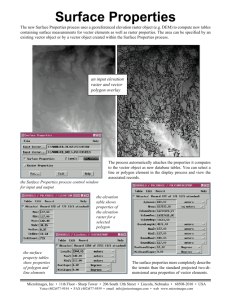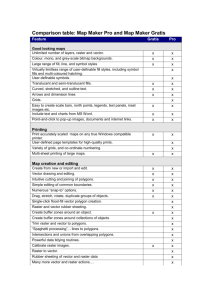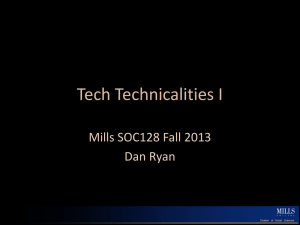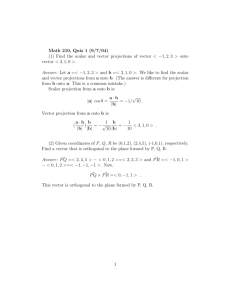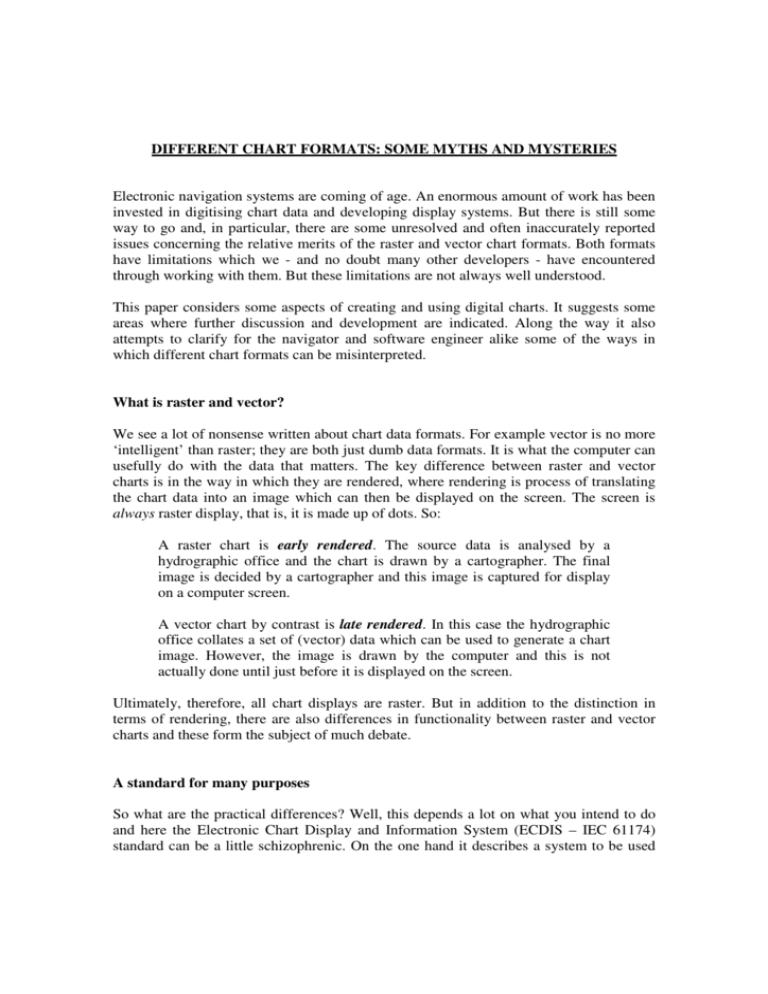
DIFFERENT CHART FORMATS: SOME MYTHS AND MYSTERIES
Electronic navigation systems are coming of age. An enormous amount of work has been
invested in digitising chart data and developing display systems. But there is still some
way to go and, in particular, there are some unresolved and often inaccurately reported
issues concerning the relative merits of the raster and vector chart formats. Both formats
have limitations which we - and no doubt many other developers - have encountered
through working with them. But these limitations are not always well understood.
This paper considers some aspects of creating and using digital charts. It suggests some
areas where further discussion and development are indicated. Along the way it also
attempts to clarify for the navigator and software engineer alike some of the ways in
which different chart formats can be misinterpreted.
What is raster and vector?
We see a lot of nonsense written about chart data formats. For example vector is no more
‘intelligent’ than raster; they are both just dumb data formats. It is what the computer can
usefully do with the data that matters. The key difference between raster and vector
charts is in the way in which they are rendered, where rendering is process of translating
the chart data into an image which can then be displayed on the screen. The screen is
always raster display, that is, it is made up of dots. So:
A raster chart is early rendered. The source data is analysed by a
hydrographic office and the chart is drawn by a cartographer. The final
image is decided by a cartographer and this image is captured for display
on a computer screen.
A vector chart by contrast is late rendered. In this case the hydrographic
office collates a set of (vector) data which can be used to generate a chart
image. However, the image is drawn by the computer and this is not
actually done until just before it is displayed on the screen.
Ultimately, therefore, all chart displays are raster. But in addition to the distinction in
terms of rendering, there are also differences in functionality between raster and vector
charts and these form the subject of much debate.
A standard for many purposes
So what are the practical differences? Well, this depends a lot on what you intend to do
and here the Electronic Chart Display and Information System (ECDIS – IEC 61174)
standard can be a little schizophrenic. On the one hand it describes a system to be used
for navigating a vessel; on the other it describes a system for passage planning.
Intuitively these two activities seem closely related. In practice they can be very different.
A system to help in actually navigating a passage will sit at the front of the bridge and in
many ways behave like the radar. Specifically it should be a virtually hands-free
operation. The screen should show the mariner exactly what they need to know
automatically. There will be very few controls. A passage planning system is a very
different proposition. There is no real-time imperative but there is a lot of disparate
information to assess and collate. This will be a highly interactive system allowing the
navigator to explore many possibilities and consider many factors.
ECDIS also has an underlying tendency (or some would say even an agenda) to attempt
to de-skill bridge operations. Nominally, the purpose of ECDIS is to improve the
information available on the bridge. Is it the role of the computer also to make decisions
about how the vessel should be navigated? This seems unlikely but then what is the
purpose of route checking alarms, for example? SOLAS vessels are not navigated like
dodgem cars and the navigator should be carefully inspecting the planned route. How far
do we rely on the computer to tell us whether a passage will be safe?
In our view, there are other areas where the ECDIS standard in its current form is
someway short of being truly fit for purpose and some of these problems are touched on
below. The evolution of the standard could no doubt improve the situation, but it is
important to understand that there are standard-related issues, as well as those related to
programming or navigation.
From paper to pixels
We believe the original paper charts are often very difficult to improve in key respects.
They are created to the best scale, cover the best area, display just the right amount of
data, with just the right level of detail and so on. We can make this claim because they
have been refined over many years (sometimes 200 years) to give the mariner exactly
what they need for certain purposes. Because of this, raster charts, which are facsimiles
of the original charts, should make a good choice for a navigation system. Without any
user intervention they display navigational information with just the right level of
consistent detail. Ideal for real navigation. They are also familiar, a factor which should
not be underestimated. Familiarity helps enormously with ease of use and also has
significant safety implications - although it seems likely that new and younger mariners
less steeped in grand traditions may be less affected by this.
Consequently one might consider that vector charts would be better suited for planning
purposes because they offer so much more control over display properties. However,
interestingly a company called AtoBviaC Ltd are just embarking on a large project to
create distance tables for the world. This is effectively a massive passage planning
operation using a team of master mariners. They have expressed a strong preference to
use official raster charts exclusively. To understand why is to understand more clearly
some of the problems involved in vector charting.
At the UK Hydrographic Office, and many other national Hydrographic Offices, vector
data (ENC) is created by tracing over the raster data. The significance of this cannot be
overstated. The best quality image possible from this data can only ever approach the
original raster image. When the electronic navigation chart (ENC) is displayed, with all
possible display options enabled, the total amount of display information will still only
approximate to that available from the raster image.
So a reasonable way to consider the difference between vector and raster without getting
embroiled in technical computer discussions is to consider the consequences of early and
late rendering.
Rendering
Early rendering means basically letting the cartographer do his job. This work is not only
highly skilled but also time consuming. It is not unknown for a cartographer to literally
spend all day looking at a new edition of a chart just to make sure that the layout and
labelling and detail and myriad other factors are all just so; just right to make the chart
clear, concise, uncluttered and useful for the navigator. Another critical stage in raster
chart production is anti-aliasing. This is a data manipulation technique that allows raster
display device, such as a computer screen, to display a much better representation of
certain types of image. For example, in Figure 1 below, the sharpness and clarity of the
image is significantly degraded without anti-aliasing.
Figure 1: The left hand image is anti-aliased to create a visually smoother line
With late rendering the computer has to attempt to duplicate this production process in a
small fraction of the time. If the system is to sensibly support scrolling and zooming then
a full screen of chart needs to be rendered in a few tens of milliseconds. Even on the
fastest of computers this is only possible so long as the system restricts itself to just few
simple rules. For the developer, this is a significant problem. We think our vector display
systems are quite fast but it has been an immense task to get to that position.
In principle, a sophisticated program could attempt the sort of complex layout used on a
paper chart. This involves curved labels, many different fonts, moving labels around to
avoid certain features or each other and so on. In practise, and for the time being at least,
this level of computing intelligence is impossible in the available time. Furthermore, the
ECDIS standard would need a substantial re-write to support such a process. Both of
these problems could be solved with better technology and the further evolution of
ECDIS. But we do not recommend that you start holding your breath in anticipation of an
early and significant improvement.
So certain degrees of complexity are beyond us for the moment - which means keeping
things simple. And the trouble with simple rules is just that, they are simple. Possibly too
simple. It becomes very easy to display an image with too much or too little detail, both
important safety issues. Clutter can obscure important features and lack of detail may
omit critical features altogether. Anti-aliasing is not (currently) a realistic proposition and
this is what causes the typically harsh and bitty appearance of vector charts. Dynamic
positioning of labels combined with the myriad of display options such as depth shading
means that a portion of chart can be displayed in many different ways. Sometimes even
scrolling a small distance can be enough to change the basic look and feel of the
displayed chart. Recently we encountered a complaint: “some of the symbols are
following my ship!” This was actually perfectly correct ECDIS behaviour and simply a
consequence of the dynamic nature of area centred symbols.
Layering and Display Scales
Vector systems allow chart detail to be added or removed. This is advertised as a good
thing and it has uses in certain specific areas. For example with the use of Additional
Military Layers (AML) it may be desirable to display multiple views of the same area
with different views focusing on different types of military information, as well as a
separate view for navigation. This is of course outside the remit of ECDIS. For SOLAS
type use it is hard to argue that any feature should be optional. Either the navigator needs
to be aware of an item on the chart or they do not. However, in practice, vector systems
need to have options to control detail level because otherwise the display suffers badly
from either clutter or scarcity. This is a direct consequence of the simple rules that need
to be used by the computer to design the layout. The mariner now needs to understand the
display options from a cartographic point of view so that they can make additional
decisions to configure the display. There are a lot of options. Are you really sure that the
chart is showing you everything you need to know?
Each feature in a vector chart can have a minimum display scale associated with it. The
intention of this is that the feature should not be displayed at chart scales below this. It is
a simple mechanism to help de-clutter images that cover a large area. Unfortunately is it
rarely used in commercial ENC data. The reason is simple; the producing Hydrographic
Office has to consider each feature and decide whether or not it should be displayed at a
particular scale. This is a remarkably onerous and difficult job. It cannot be automated –
if it could then we could replace the value with a rule and let the computer decide. So
unfortunately the value cannot be relied on and so is of limited use. The images become
more susceptible to clutter and the user is forced to play with the display settings to get a
useful chart image. Achieving an uncluttered display is of little consolation after a
collision.
Figure 2: Comparison of Raster and Vector images
Overall, the effect of late rendering is one of uncertainty. Features can come and go
depending on display scale and a myriad of settings. Simplified symbols may be in use to
reduce clutter. Annotations can occupy changeable positions in relationship to the
features they are labelling. Features can be displayed in different ways. The whole chart
can be rotated. Stability in the chart display should be paramount. A navigator needs to
be able to easily and quickly orientate themselves on a chart. This task is significantly
harder on an ENC. If an incident happened there is no way that an accident investigator
could confidently determine exactly what the navigator was seeing on the chart. But there
are other problems with vector charts, of which the four below have entertained us from
time to time.
Updating Charts
Updating paper charts is tedious and time consuming. But it has one big advantage – the
user is focused on the changes. Even afterwards, other people can see where the changes
have been made as they admire the handwriting and glue smears. Updating ARCS is fast
and easy. It is also very easy to spot where updates have been applied. See figure 3.
Updating ENCs is similarly fast and easy but the results are far less clear. If the update is
a visible difference then you need to make sure that the scale and display options are
correctly set so as to make the feature visible. If the change is to an attribute which does
not contribute to the appearance of an object then the change will be very difficult to find.
There are various schemes which attempt to highlight changes but these can only indicate
an area – where there may be many objects. The update in figure 4 is not visible at any
larger scales.
Figure 3: The location of an update is indicated by a border
Figure 4: Two ENC views – spot the update
Zooming, magnifying and changing scale
The ability to arbitrarily zoom a chart display is often cited as being an advantage of
vector data over raster, but the truth is less clear cut. For a start arbitrary zoom levels can
be confusing. Working with well defined and regular scales (eg 1:200,000, 1:50,000, etc)
is generally less likely to cause disorientation. However, the real problem is one of detail
levels. How much detail should be displayed at any particular scale? Cartographers have
solved this problem. They have picked certain display scales to work with and they have
tailored the amount of detail to be appropriate. Over time the charts have been improved
and refined. With late rendering the computer has to make it up as it goes along and this
inevitably and commonly leads to a scarcity or over abundance of features.
But what does it actually mean to ‘zoom’ a chart? For a vector chart it means changing
the display scale. For a raster chart it also means changing the scale. However it is
sometimes erroneously taken to mean magnifying the screen image. This is comparing
apples with oranges. If a portion of vector chart is magnified (electronically or by putting
a magnifying glass in front of the screen) it shows just the same heavy pixilation, and
distortion that would affect any image including raster charts (Figure 5). If we change
the display scale in a raster chart system it means we load a new chart of a different scale.
This looks fine. In fact it usually looks better than the vector image of the same area. The
number of display scales is limited because they have been determined during the early
rendering process. As discussed above it is probably safer to limit display scales to a few
common values so this is not necessarily a bad thing.
Figure 5: Magnifying raster or vector causes the same problems
Display scale and clutter are related. In general if a vector chart display is cluttered then
this can be reduced by zooming in. It means there are fewer objects to display on the
same portion of screen. In practise zooming is essential to vector systems as a mechanism
for controlling clutter. But it can also be very dangerous. A raster chart should be
displayed at its intended scale. Using magnification in a bridge situation is probably a bad
thing to do. Since the chart is displayed as intended the size of certain features will be
displayed in way consistent with their accuracy. For example, the edge of a pier will be
known to within the width of the line used to draw the edge of the pier. A vector chart of
a similar scale will generally draw the pier edge in a similar way. This is all fine until the
vector system is used to zoom in on the pier. If the image is zoomed ten times then the
uncertainty about the exact position of the edge as displayed on the screen has increased
ten times. However the system will draw this edge with exactly the same line. There is no
clear indicator that the line should really be ten times thicker because at this scale it
cannot genuinely be represented any more accurately. This has happened. In a recent
incident involving a 60m positioning error it turned out that the chart being used was over
zoomed. The system showed an over-scale warning in the correct way but none the less
the navigator believed what the chart on the screen was showing him.
So, zooming is not an advantage of vector charts over raster charts. It is simply a
prerequisite for usable vector charts.
This incident also highlights another important aspect of computer assisted disasters
which is the tendency for over optimistic belief in the information displayed by a
computer. In any system that is converting paper charts to ENC the data quality cannot be
improved. Under some circumstances it can actually be degraded because of the way that
paper charts were never really intended to be absolutely accurate in a universal frame of
reference: they were really only designed to be consistent within the chart and suitable for
relative navigation. Publishing this information as ‘state-of-the-art’ ENC data can easily
create an illusion that the data is actually of better quality than it really is. ENC charts do
not contain a Source Data Diagram. It is hard to determine whether or not the chart data
you are using originated with the HMS Beagle. ENC does contain a data quality indicator
but this is, at best, a poor substitute.
The projection myth……
The ENC product specification (4.3) specifies that no projection is used. This causes a
problem when considering what is meant by a straight line. That is - what is the path to
follow between two points? The question is not significant for points close together (less
than about 6 km) however if the two points are several hundreds of miles apart then there
is a big problem.
A simple and common definition of a straight line is that it is the shortest distance
between two points. For navigating around the earth, that would mean a Great Circle. But
that does not seem to be what is intended with ENC. In practice, the nature of a straight
line is actually determined by the manufacturer - hardly what Euclid had in mind.
Specifically, it is what appears to be the shortest distance between two points when they
are projected onto a plane surface. This means that there is an implicit projection. It
means that to qualify the data fully we need to know the projection that was used to
create the chart in the first place. A further clue can be found in the co-ordinate system.
Geodetic latitude and longitude are well suited for describing a flat, square surface but
cause problems (singularities) when applied to an oblate spheroid. Putting these two
points together we guess (we have not enquired) that the originators of the ECDIS
standard considered the starting point for generating vector data to be a Mercator chart
and that a straight line is actually a Rhumb line.
Why does this matter? Well the straight line problem has several ramifications. The
centre point of a long (6km or greater) line will only be in the correct place if the chart
manufacturer and the display manufacturer have agreed on the projection to use (and
‘correct place’ here means within the smallest resolution of a computer screen – which is
a pixel).
Further, Rhumb lines get very tricky at high latitudes. If you were 100m from the South
Pole and you followed a rhumb line at 90 degrees then you would walk round in a circle
of 100m radius. This is not a good definition of a straight line. Real route legs would
need to be constructed of many short lines in the world as it is according to S57 and the
ECDIS standard.
Figure 6: Not a good definition of a straight line
At the moment most S57 viewers use a simple cylindrical projection because this is
computationally the quickest way to convert geodetic coordinates into pixel coordinates.
However a cylindrical projection is a pretty limited view of the world and is next to
useless for high latitude visualisations; just what is the longitude of the North Pole? Even
at moderate latitudes severe distortions can be introduced. Incidentally the current raster
(ARCS) specifications cannot support polar mapping either.
Figure 7: Two equal sized areas joined by a (shortest) straight line.
……And the way ahead
When working with bits of paper we learn to put up with this stuff. Paper charts require
precise projections so that accurate bearings and distances can be plotted using a pencil
and simple instruments (dividers, protractors and parallel rule). Not so the computer
displayed chart – the calculation of accurate bearings and distances can be handled
entirely separately from the display of the chart. The display of the chart should focus on
speed and being reasonably distortion free. Why should we expect shapes to be more or
less distorted because of their latitude? If we clear our minds of historical chart clutter
and consider the world in its full 3 dimensional glory then it becomes apparent that a 3D
coordinate system is going to be much more appropriate, Projection issues now genuinely
vanish because the data will now describe a the surface of the planet directly rather than
describing a 3D surface one it has been flattened to a 2D surface. The flattening
(projection) can come later as was apparently the intent with S57. Recall that this is a late
rendered system; the projection can even be changed dynamically even as the chart is
scrolled. This is all starting to sound complex so to jump to the conclusion: if 3D data is
used then an intuitively simple bird’s eye view (technically a tangential projection) would
be readily feasible. A tangential projection is way we naturally see the world. It limits
distortion and does not have any problems with high latitudes. This is of course possible
now but involves an awful lot of pre-processing of the data.
Datums
Local Horizontal Datums are something many mariners wish would go away but
unfortunately, we cannot ignore them. Local datums are important; much of the local
advice and knowledge will be using the local datum. Positions may need to be transferred
between local charts and the ECDIS. Differences between the local datum and WGS84
can introduce shifts of up to a kilometre. ENC make no concession to local datums at all.
This means that all local positions have to be converted to WGS84 externally to the
ECDIS.
Figure 8: Non-linear nature of local datum shifts.
Reproduced from NP288 by permission of UKHO
ARCS charts contain local datum transformation information (fifth order polynomial)
which allows the local datum to be used as easily and accurately as WGS84. Doing the
conversion externally may not be very precise. A contemporary GPS can give a very
accurate WGS84 position however converting this to and from local can be awkward.
The GPS will often be able to do the conversion; it could also be done manually or with a
computer program. However these will typically only ever use a simple fixed offset
(linear shift) for the whole extent of the datum. As figure 8 shows this can be an
oversimplification. To do an accurate conversion really needs chart specific information.
In April this year Primar recommended that unofficial vector data should be preferred by
navigators over raster data where ENC coverage was not available. Much of this unofficial vector data is traced from paper charts. Less than 40% of the UKHO chart
portfolio (6,550+ plans) is referenced to WGS84 and approximately 30% of the portfolio
cannot be related to any known datum at all. The UKHO position on this is that without
WGS84 referencing there can be no official ENC chart. You can purchase unofficial
vector charts for pretty much anywhere. Guess how unofficial vector providers deal with
chart data of no known datum? Guess how many mariners using high-tech computer
navigation systems actually understand how woefully inaccurate some of this third hand
chart data is.
Conclusion
We know that there may be other points of view on the raster-vector debate. We know
that many people are working hard at vector charting - and so are we. We also know that
the construction and maintenance of an international standard such as ECDIS is complex,
tortuous and - let us be honest - often plagued by political or commercial concerns. But in
the ten years during which we have been working with electronic navigation software it is
striking to see the extent to which there are still such wide differences of opinion on some
issues.
If we were being uncharitable we would say that there has been some muddling thinking
at times. But whether or not that is the case it is clear that the both the technology and the
market environment for electronic charting is still relatively immature. We can surely
expect continued development of both in coming years and this may lead to better
solutions to some of the problems we have highlighted.
But for that process to go forwards as quickly as it can the debate about some of the
issues needs to be very clear. All too often, as we hope we have illustrated here, it is not.
After all, safety, as ever, is paramount. Indeed, it is a central reason behind the difference
between vector charts and raster charts in terms of acknowledged parity with paper
charts. The newcomer to the field would conclude from this that vector charts were the
safer option. As the zooming issue alone shows, it is far from obvious that this is the case.
Simon Salter, September 2003
Copyright © 2003, Simon Salter, CherSoft Ltd. All rights reserved.
simon@chersoft.co.uk
http://www.chersoft.co.uk

